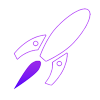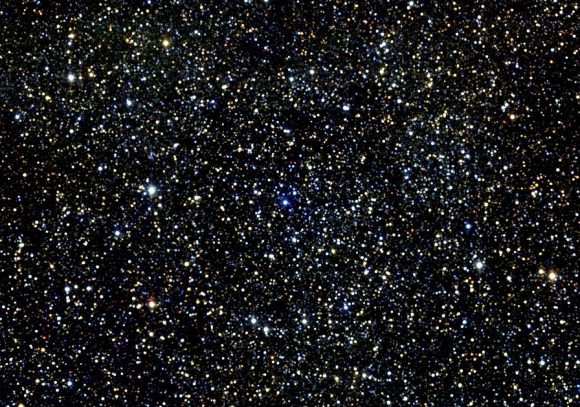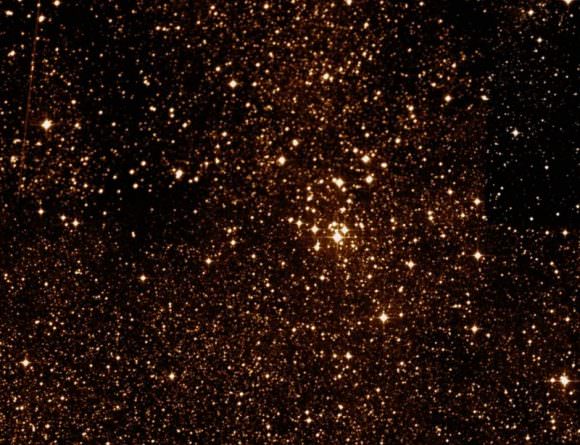Welcome back to Messier Monday! In our ongoing tribute to the great Tammy Plotner, we take a look at the Messier 21 open star cluster. Enjoy!
Back in the 18th century, famed French astronomer Charles Messier noted the presence of several "nebulous objects" in the night sky. Having originally mistaken them for comets, he began compiling a list of these objects so that other astronomers wouldn't make the same mistake. Consisting of 100 objects, the
Messier Catalog
has come to be viewed as a major milestone in the study of Deep Space Objects.
One of these objects is Messier 21 (aka. NGC 6531), an open star cluster located in the
Sagittarius
constellation. A relatively young cluster that is tightly packed, this object is not visible to the naked eye. Hence why it was not discovered until 1764 by Charles Messier himself. It is now one of the over 100 Deep Sky Objects listed in the Messier Catalog.
Description:
At a distance of 4,250 light years from Earth, this group of 57 various magnitude stars all started life together about 4.6 million years ago as part of the Sagittarius OB1 stellar association. What makes this fairly loose collection of stars rather prized is its youth as a cluster, and the variation of age in its stellar members. Main sequence stars are easy enough to distinguish in a group, but low mass stars are a different story when it comes to separating them from older cluster members.
[caption id="attachment_130118" align="aligncenter" width="580"]
Atlas mosaic image of Messier 21 (NGC 6531) obtained as part of the Two Micron All Sky Survey (2MASS). Credit: 2MASS/UofM/IPAC/Catech/NASA/NSF
[/caption]
As Byeong Park of the Korean Astronomy Observatory said in a
2001 study
of the object:
But study it in detail they did, finding 56 main sequence members, 7 pre-main sequence stars and 6 pre-main sequence candidates. But why did this cluster... you know, cluster in the way it did? As Didier Raboud, an astronomer from the Geneva Observatory, explained in his 1998 study "
Mass segregation in very young open clusters
":
[caption id="attachment_130122" align="aligncenter" width="580"]
Achernar, the flattest star known, is classified as be star. Credit: earthsky.org
[/caption]
But are there any other surprises hidden inside? You bet! Try Be-stars, a class of rapidly rotating stars that end up becoming flattened at the poles. As Virginia McSwain of Yale University's Department of Astronomy wrote in a 2005 study, "
The Evolutionary Status of Be Stars: Results from a Photometric Study of Southern Open Clusters
":
History of Observation:
Charles Messier discovered this object on June 5th, 1764. As he wrote in his notes on the occassion:
[caption id="attachment_130121" align="aligncenter" width="580"]
Close up of the Messier 21 star cluster. Credit: Wikisky
[/caption]
While Messier did separate the two star clusters, he assumed the nebulosity of M20 was also involved with M21. In this circumstance, we cannot fault him. After all, his job was to locate comets, and the purpose of his catalog was to identify those objects that were not. In later years, Messier 21 would be revisited again by Admiral Smyth, who would describe it as follows:
Locating Messier 21:
Once you have become familiar with the Sagittarius region, finding Messier 21 is easy. It's located just two and a half degrees northwest of Messier 8 - the "
Lagoon Nebula
" - and about a half a degree northeast of Messier 20 - the "
Trifid Nebula
". If you are just beginning to astronomy, try starting at the teapot's tip star (Lambda) "Al Nasl", and starhopping in the finderscope northwest to the Lagoon.
[caption id="attachment_130119" align="aligncenter" width="471"]
The location of M21 in the Sagittarius constellation. Credit: IAU/Sky & Telescope magazineRoger Sinnott & Rick Fienberg
[/caption]
While the nebulosity might not show in your finder, optical double 7 Sagittari, will. From there you will spot a bright cluster of stars two degrees due north. These are the stars embedded withing the Trifid Nebula, and the small, compressed area of stars to its northeast is the open star cluster M21. It will show well in binoculars under most sky conditions as a small, fairly bright concentration and resolve well for all telescope sizes.
And here are the quick facts, for your convenience:
- Object Name
-
Messier 21
- Alternative Designations
-
M21, NGC 6531
- Object Type
-
Open Star Cluster
- Constellation
-
Sagittarius
- Right Ascension
-
18 : 04.6 (h:m)
- Declination
-
-22 : 30 (deg:m)
- Distance
-
4.25 (kly)
- Visual Brightness
-
6.5 (mag)
- Apparent Dimension
-
13.0 (arc min)
We have written many interesting articles about Messier Objects here at Universe Today. Here's Tammy Plotner's
Introduction to the Messier Objects
, ,
M1 – The Crab Nebula
,
M8 – The Lagoon Nebula
, and David Dickison's articles on the
2013
and
2014
Messier Marathons.
Be to sure to check out our complete
Messier Catalog
. And for more information, check out the
SEDS Messier Database
.
Sources:
- *Messier Objects - Messier 21*
- SEDS Messier Database - Messier 21
- *Free Star Charts - M21 Open Star Cluster*
 Universe Today
Universe Today




